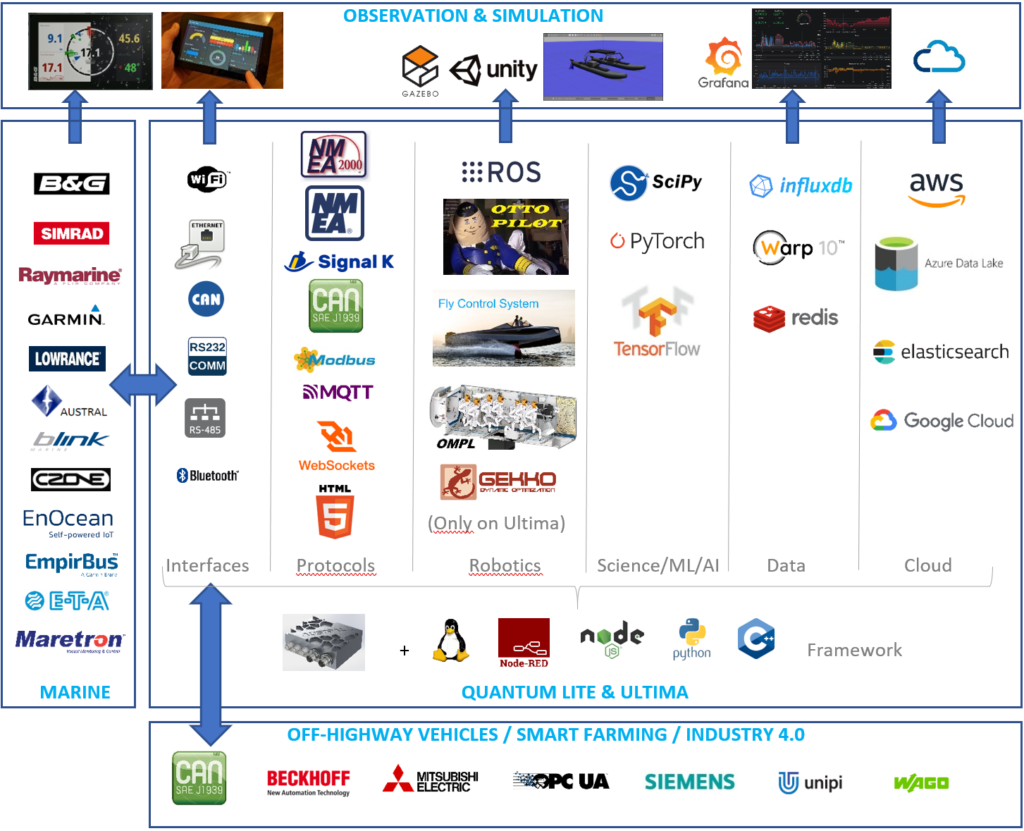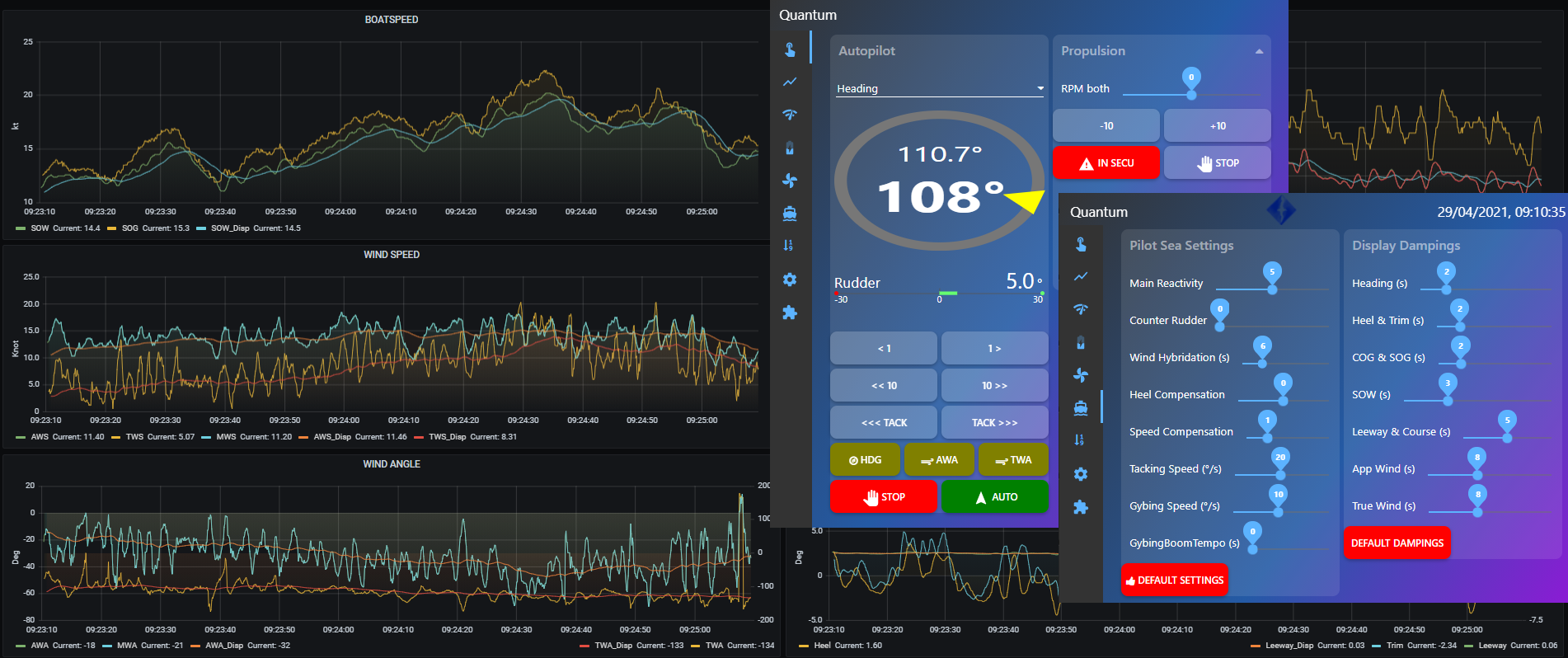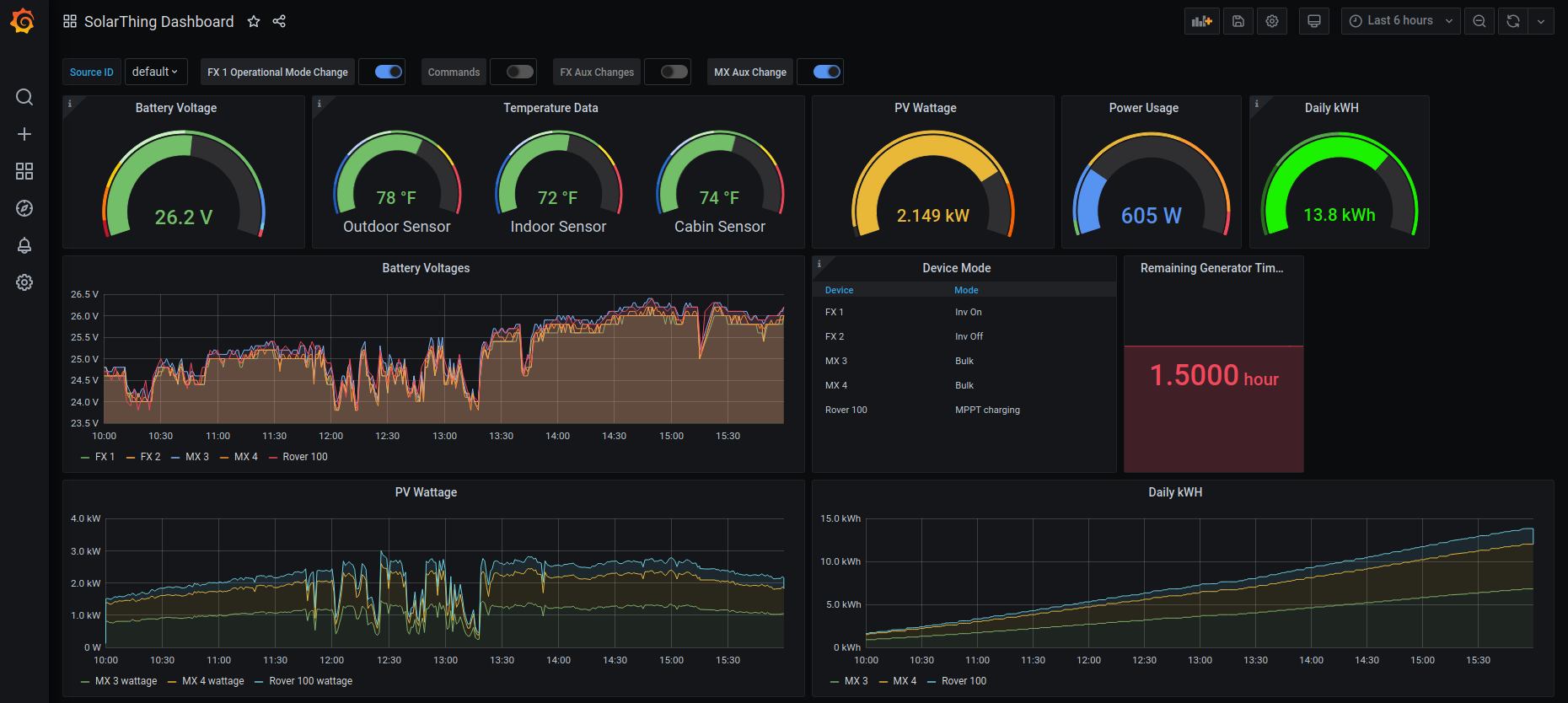RED Carpet is an open, fast, agile and intuitive system integration framework for marine, industrial IoT and unmanned vehicles.
It reduces costs and delays of your project. It allows you :
- The interfacing of your instruments in a few minutes, via near 4000 available nodes (IP, NMEA, PLC, Home automation…).
- The realization of a modern man-machine interface in a few hours, compatible with all web browsers like marine MFD multifunction displays or industrial panel.
- A visual development, system understanding and troubleshooting accessible to all (drag & drop, No-Code/Low-Code, Visual status)
- To easily manipulate your data.
RED Carpet is a technology derived from high competition sailing and drones. It is a suite of several software that provides a rapid development infrastructure for :
- Managing Data : perception, collection, dissemination, cloud, data mining…
- Observability & HMI : Web Dashboard, Augmented reality, Voice assistant..
- Intelligence : Deep learning, image recognition…
- Autonomous decision making : Embedded model, HIL Simulation, obstacle avoidance, motion planner, control, navigation, guidance…
- Advanced functional requirements : Cobotics, Generalized integration, Operational versatility, Mission adaptability, Dependability, Self-diagnosis, Remote troubleshooting…
PLATFORMS: The suite can be installed using a script on all Debian Linux platforms :
- AUSTRAL electronics linux rugged mission computers or IoT Gateways : Quantum CM4 OEM.
- The Raspberry PI Ecosystem.
APPLICATIONS:
- Interfacing sensors, actuators and PLCs
- Data collection, Black box
- Marine IOT, IIOT, Cloud
- IA, Robotics, Command control, Guidance
- Asset tracking, Machine monitoring, Energy Management
- Building, boat and vehicle automation, Security systems, Climate control
- HTML5 Multifunction Displays Dashboards, Voice Assistant
SECTORS: IoT Gateway, Industry 4.0, Marine, Smart boat, Oceanography, Drones, Robotics, Specialty Vehicles, Smart Farming …
THE GENESIS
RED Carpet and the Quantum mission computers are the result of 30 years at the highest level of electronics and robotics in hostile environments (marine, underwater…).
The needs and findings of the feedback are :
- Get to the point :
- We spend 90% of the development time of a project in the ‘packaging’ (specifications, synoptic and documentation, hardware, OS, compilation tools, writing protocols, datalog/game, bugs, qualifications) and 10% in the algorithm that we want to develop and test.
We need an architecture that does not reinvent the wheel for each project - It is necessary to be able to develop remotely, because the time, cost and complexity of the machine is often incompatible with the creation of a test bench.
- A pre-study step under matlab and then a porting on a target is useless when we can realize simulations directly on the target in Python SciPy
- We spend 90% of the development time of a project in the ‘packaging’ (specifications, synoptic and documentation, hardware, OS, compilation tools, writing protocols, datalog/game, bugs, qualifications) and 10% in the algorithm that we want to develop and test.
- Managing the data deluge :
- The number of data and connected points are increasing exponentially and with more and more protocols from the internet world such as websocket, micro web servers for displays integrating a browser, MQTT, this will continue with the connected objects via StarLink.
- The CPU time taken to manipulate data through drivers and protocols has become predominant over the mathematical calculations at the heart of an application.
A classical multithreading and sequential architecture (with all tasks waiting for data and in permanent context change) is less and less relevant to the asynchronous programming used successfully by the big names of the web. - We need tools adapted to the recording and analysis of large volumes of data.
- Managing the growing complexity of systems :
- We need to compensate for this complexity with visual programming.
- The qualification time explodes with this complexity of applications, a modular and compartmentalized system is needed which limits the qualification to the last developments and facilitates the development to several.
- A hardware-in-the-loop simulation system is needed to minimize real-life testing.
- Functional reliability must be guaranteed despite the increasing complexity.
- Often, a simple false contact can quickly turn into a nightmare or even a catastrophe. Any user or technician must be able to locate problems quickly, even from a distance.
- A good understanding of the system is based on synoptic diagrams, associated with a programming by non-blocking events, these are assets in order to ensure degraded modes and redundancies.
- Evolve :
- Computing is increasingly adapting to humans and moving away from the machine. Natural interfaces (voice, gestures, drawings…) are the interfaces of tomorrow in use but also in programming.
- We need an architecture that allows us to quickly evaluate new technologies.
THE FRAMEWORK
RED Carpet answers these problems while offering the possibility of relying on a powerful, robust, scalable, documented, and above all easy-to-use software infrastructure in order to save precious time and concentrate on the algorithms that we wish to develop.
For this, the RED Carpet suite relies on popular open source solutions :
- Node JS is a stroke of genius by Ryan Dahl, who in 2009 used the ultra-efficient Java-Script & WebAssembly V8 compiler from Google on the server side. Node JS has revolutionized the Web world by its performance and the fact that you only need to know one language to make the Web. Today, Node JS has supplanted other technologies and is massively used by all the big names in the web but also in critical applications, for example, by SpaceX in its Dragon capsule.
- Node-Red was written by IBM, released in 2019 after 6 years of development and improvements. The 2 projects Node Js and Node-Red are technologies supported by Google, Microsoft, IBM …
- Node-Red 2.0 is a mature technology that is no longer reserved for prototyping only. It has been chosen by leading manufacturers for professional use in PLCs and IoT platforms (Fujitsu, GE, Intel, Samsung, Schneider, Siemens, Weidmüller …), as well as in the field of cloud services (AT&T, Cisco, Fujitsu, Hitachi, IBM, Nokia, Siemens …).
- Python is the reference for Data Science and open source AI because of its simplicity of learning and its libraries.
- The 2 most used languages today : Python and JS.
- A bubbling community :
- Hundreds of videos, tutorial sites and connected object demos.
- Hundreds of thousands of modules and examples.
Node-Red is :
- A use and understanding of the system within the reach of everyone via a simple web interface, very visual and practically without coding. The system is described in the form of a flow graph, the code is limited to a few ad hoc functions and entered directly into the Web browser.
- A very powerful system optimized for data exchanges thanks to its Node JS sequencer written in C++ which offers asynchronous and non-blocking event management.
- A robotics middleware : Austral is constantly improving the real-time aspect of the Linux RT solution, Node JS sequencer and V8 engine and is developing optimized business nodes. The proposed solution is also a robotics middleware which allows to obtain an average latency time of about 3ms in the case of a 3D MIMO control and with a robustness compatible with robotics applications of non-critical systems whose trajectory is controllable at 50Hz (for example a machine of more than 20 Kg at less than 100km/h). If necessary, the joint use of ROS2 allows you to control your machine up to 300Hz.
- Built-in safety :
- Continuous Built In Test.
- Setting of fail safe priorities.
- Easy damage location.
- Customizable dashboards and graphs (mobile, desktop, MFD)
- Scalable functionalities without coding by importing new ‘nodes’ and adapting the examples proposed by the Node-Red and Austral ecosystems.
- Cost and time reductions
SPECIFICATIONS

- Features for IoT, Industry 4.0, Automation, AI (free, open source) :
- HMI/Observability : node-red-dashboard, Grafana, Voice Synthesis/Control (via Bluetooth) .
- Digital Twin / Web viewer : Interactive SVG/scadavis.io Dashboard (2D Vector graphics), Babylonjs/three.js (3D)
- Scripts : NodeJS, Python
- Embedded Data Collection / Time Series Database : InfluxDB, Warp 10
- Cloud bridges / Big Data : Redis RAM cache, Amazon Web Services AWS, Google Cloud Platform CGP, Microsoft Azure Data Lake, Elastisearch
- Signal Processing / Data Science / IA : SciPy, PyTorch, TensorFlow
- Marine Interfaces : NMEA0183, Signal K, Websocket, MQTT, TCP, UDP…
- Automotive & industry Interfaces : Modbus, OpcUa, Siemens S7, WAGO PFC, Beckhoff, Unipi, Misubishi…
- Advanced features for marine and robotics (paid, closed source code) :
- HMI/Observability : marine MFDs HTML5 app, marine user variables (B&G/Garmin/Simrad), J1939 Keypads.
- Marine Interfaces : NMEA2000 (PGNs Simrad, B&G, Garmin), J1939 (Volvo, Mercury), B&G Expansions, Maretron, EmpirBus, CZone, ETA, Blink Marine, EnOcean…
- Command and control : Autotune PID, Unsupervised Learning Control (Beta) , Flight Control System, Using SciPy or GEKKO : LQR, Optimal Control, MPC, NMPC…
- Motion planning 2D/3D : Waypoints-Routes-Following lines, Constraints by vector fields, OMPL.
- Robotics & simulation bridge : ROS2, Gazebo, Unity
More descriptions on the RED Carpet Wiki
USER INTERFACE & HTML5 App Marine Multi-function Display (MFD)
The user interface served by RED Carpet is touch-sensitive, it automatically adapts to your screen resolution and is compatible with all HTML5/CSS3 browsers on all supports: Mobile, Tablet, PC, Panel PC, Web Panel, Android Panel…
For harsh environments: The user interface can be combined with J1939/NMEA2000 knobs and keypads and can be integrated as an HTML5 App in one of the MFD display pages integrating a web browser as well as Wifi or Ethernet connectivity:
- B&G :
- Vulcan (7 & 9″ – 800×480, 12″ – 1280×800)
- Zeus 3S (9 & 12″ – 1280×720, 16″ – 1920×1080)
- Zeus3 Glass Helm (16,19,24″)
- Nemesis (9 & 12″ – 1280×720)
- FURUNO :
- NavNet TZtouch3 series TZT12F, TZT16F, TZT19F (12,15.6,19″) (Software version >= v1.08)
- Navnet TZtouch2 TZT2BB Black box (Software version >= v7.01)
- GARMIN :
- EmpirBus & OneHelm TD50 (5″ – 800×400)
- OneHelm GPSMAP® 723/923/1223 (7″ – 1024×600, 9 & 12″ – 1280×720)
- OneHelm GPSMAP® 84xx (10, 12, 16, 22, 24″)
- LOWRANCE :
- HDS Live (7, 9, 12, 16″)
- HDS Carbon (7, 9, 12, 1 “)
- RAYMARINE :
- Axiom + (7″ – 1024×600, 9″ – 1280×720, 12″ – 1280×800)
- Axiom (7 & 9″ – 800×480, 12″ -1280×800)
- Axiom Pro (9, 12, 15.6″)
- Axiom XL (15.6, 18.5, 21.5″)
All Axiom MFDs running on LightHouse 3 (software version >= v3.11).
The eS & gS Series multifunction displays which have been upgraded to LightHouse 3 are not compatible.
- SIMRAD :
- Go7 XSR (7 “)
- Go9 (9 “)
- Go12 (12 “)
- NSO EVO2 (16, 19, 24 “)
- NSO EVO3 (16, 19, 24 “)
- NSS EVO3 (7, 9, 12, 16 “)
Note : Go5 and Go7 XSE not compatible
TARGET MARKETS
- Connected boat, Smart ship, Marine IOT.
- Competition sailing, Superyacht, Ships of the future.
- Drones :
- Marine : surface USV / Drone-ship, submarine AUV
- Land-based: Agricultural, autonomous delivery….
- LARS (Launch and Recovery System)
- Docking Station
- Oceanography (Instrumented buoys, Profilers, Submersible stations…)
- Marine Renewable Energy.
- Off-Highway vehicles (Smart Farming, Specialized trucks).
- Industry.
TARGETED APPLICATIONS
- Automation: Voice Assistant, Energy Management, Alarm…
- Maritime IOT and AIOT Gateway.
- Control and command of complex kinematics.
- 2D/3D autonomous navigation, Obstacle Avoidance System, Motion Planning, Docking.
- Mission control.
- Data collection (oceanography, marine energy…).
- Rapid development platform for safety and performance optimization (Machine Learning, Image Recognition).
PARTICIPATE IN THE RED CARPET ECOSYSTEM
Some nodes can be closed source as libraries, pre-compiled JS or WebAssembly, as well as linked to a specific platform by a key mechanism. Many programming languages are possible: Javascript, Python, C/C++/Qt, TypeScript, Rust, Go, Java…
Austral offers to the technical partners the possibility to enhance their work through a licensing mechanism while keeping the source code confidential.
If he wishes and under his responsibility, the user has full access to the OS and is free to add applications, develop nodes and publish NPM packages or examples to the community.





